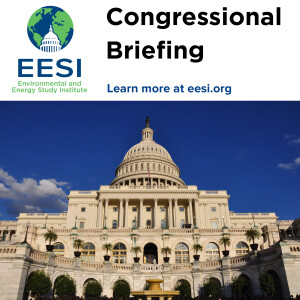Episodes

Friday Feb 28, 2025
Friday Feb 28, 2025
This briefing highlighted the ways in which onshoring the manufacturing of clean energy, energy efficiency, and electric vehicle components increases American competitiveness, secures U.S. supply chains, and creates jobs. According to the 2024 Sustainable Energy in America Factbook, in less than two years, companies announced more than $123 billion in investments in over 100 U.S. manufacturing facilities as a result of the Inflation Reduction Act. These new domestic manufacturing operations are making a diverse set of products—from solar panels and batteries to computer chips and wind turbines—in locations across the country. Research from E2 finds that these manufacturing plants are expected to create 67,000 jobs in rural areas.
Panelists discussed how this growth in domestic manufacturing supports the clean energy transition and helps meet increasing demand, all while reinvesting in the communities in which these factories operate. The briefing also explored recent Congressional actions that spurred this manufacturing boom, as well as possible policy opportunities to leverage the momentum.
View the full briefing series at eesi.org/2025climatecamps.

Tuesday Feb 18, 2025
Tuesday Feb 18, 2025
This briefing explained the processes, rules, and norms that underpin the budget, reconciliation, and appropriations debates happening right now on Capitol Hill. It explored the relationship between the presidential budget, annual appropriations, and budget reconciliation. Panelists described the different stages of the appropriations cycle and how the process interfaces with other legislative activity on the Hill. The briefing highlighted ways Congressional staff—working both on and off the budget and appropriations committees—can engage with the conversations on fiscal year (FY) 2025 appropriations, FY2026 appropriations, and budget reconciliation.

Friday Jan 31, 2025
Friday Jan 31, 2025
Ready to make a difference in climate policy, but not sure where to start? We have you covered. The Environmental and Energy Study Institute (EESI) invites you to view our start-of-the-new-Congress briefing series, Climate Camp. We review climate science, cutting-edge innovations, and the role of the legislative process in climate mitigation and adaptation.
EESI’s first Climate Camp briefing served as an interactive refresher on the drivers of climate change and the latest deployable solutions to address the challenge. This Congress, topics such as agriculture, infrastructure, and national security will be front and center. The briefing covered climate concepts and terminology—from types of greenhouse gases to renewable energy technologies—to help you identify policy solutions at the intersection of these issue areas.
At this briefing, panelists showcased tools—like the EN-ROADS simulator, co-developed by MIT Sloan and Climate Interactive—that staff can use to easily digest climate data and generate policy ideas. They also highlighted federal agency resources essential to understanding the climate challenge and innovative solutions to address it.

Friday Jan 31, 2025
Friday Jan 31, 2025
The Environmental and Energy Study Institute (EESI) held a briefing about climate adaptation, resilience, and mitigation strategies in the Columbia River basin. The Columbia, which winds through British Columbia, Oregon, and Washington state, is an important source of food, drinking water, irrigation, recreation, and clean energy for the Pacific Northwest. However, the effects of climate change have created and exacerbated problems like estuarine habitat loss, toxic algal blooms, low water levels, and diminished fish populations, highlighting the importance of finding science-based solutions to these issues.
This briefing also discussed the outcomes of the Uncommon Dialogue, which brought together tribes, national and local government, the hydropower industry, and river conservation stakeholders to identify shared approaches to steward river health and safety while ensuring hydropower operations provide clean, affordable energy. Panelists discussed the role of federal investments in the Columbia River’s resilience and health, including Inflation Reduction Act and Infrastructure Investment and Jobs Act funding.

Friday Dec 13, 2024
Friday Dec 13, 2024
The Environmental and Energy Study Institute (EESI) held a briefing about strategies to improve biodiversity and river health along the Tennessee River, which winds through Tennessee, Alabama, Mississippi, and Kentucky. The Tennessee River, one of the most biodiverse rivers in North America, experiences damaging issues ranging from PFAS and plastics to chemical pollution from landfills and manufacturing. These issues threaten both water quality and the health and well-being of the many communities in the river’s watershed.
This briefing highlighted the importance of effective enforcement of local, state, and federal clean water laws and regulations. Panelists discussed the role of federal policy-making in boosting river health, as well as opportunities to support biodiversity.

Tuesday Oct 29, 2024
Tuesday Oct 29, 2024
The Environmental and Energy Study Institute (EESI) held a briefing about the role of United States-China climate engagement in shaping the progress and outcomes of international climate governance. From critical mineral supply chains to clean energy and transportation technology, dynamics between the two countries are complex and sometimes fraught. This briefing explored how the countries’ relations across broader climate and environmental issues have influenced and will continue to influence the annual U.N. climate change negotiations.
In 2023, the United States and China produced the Sunnylands Statement ahead of the U.N. climate change negotiations (COP28), following a tradition of publishing similar joint positions in prior years. The statement covered topics related to the energy transition, forest conservation, and non-CO2 greenhouse gas emissions, including methane. It also kicked off a working group focused on “climate action in the 2020s,” which started meeting in the first half of 2024.
During the briefing, panelists explained how these bilateral interactions play into the international negotiations on climate change, outlined what to expect during COP29 and its lead up, and discussed the effectiveness of diplomatic efforts in curbing greenhouse gas emissions.

Tuesday Oct 29, 2024
Tuesday Oct 29, 2024
The Environmental and Energy Study Institute (EESI) held a briefing discussing how nations can collaborate to monitor and mitigate methane emissions to improve air quality and meet emission reduction targets. Methane accounts for 30% of the rise in global temperatures since the Industrial Revolution and has 80 times the warming potential of carbon dioxide, making it a key lever in addressing the climate crisis.
Ahead of the United Nations annual conference on climate change (COP29), this briefing covered policies nations are implementing to effectively reduce their domestic methane emissions in the energy, agriculture, and waste sectors. Panelists discussed the implementation of the Global Methane Pledge, which 155 countries have signed, and highlighted the role of technology in improving methane monitoring, compliance, and reduction.

Thursday Oct 24, 2024
Thursday Oct 24, 2024
The Environmental and Energy Study Institute (EESI) held a briefing about what Congress can expect during the upcoming United Nations climate negotiations in Baku, Azerbaijan (COP29). From the opening World Climate Action Summit to the intense negotiations of the conference’s final days, thousands of events will take place over the course of the two-week U.N. session. Whether traveling to Baku or observing COP29 from D.C., this briefing will guide policymakers on how to engage effectively.
Panelists previewed key issues on the negotiating agenda, from setting the new global climate finance goal and determining metrics for climate adaptation to updating national climate goals. The briefing also unpacked the complex process of international climate negotiations, reviewed possible policy outcomes, and explored pathways for subsequent Congressional action.

Monday Oct 14, 2024
Monday Oct 14, 2024
The Environmental and Energy Study Institute (EESI) held a briefing that examined the environmental challenges facing the Mississippi River and solutions to address them. Spanning 10 states, the Mississippi plays a key role in tourism, commerce, biodiversity, and recreation in the United States. In particular, the river system moves hundreds of millions of tons of freight each year, serves as a home to hundreds of different fish, mammal, and amphibian species, and supports 1.3 million jobs. However, like many other river systems featured in this briefing series, the Mississippi River and the communities that depend on it face challenges such as nitrate pollution, saltwater intrusion, flooding, and low water levels—many of which are exacerbated by climate change. At this briefing, Mississippi River experts discussed the role of federal policy in advancing strategies to improve both the health and climate resilience of the river system.

Thursday Oct 03, 2024
Thursday Oct 03, 2024
The Environmental and Energy Study Institute (EESI) held a briefing that explored the Inflation Reduction Act (IRA) and Infrastructure Investment and Jobs Act (IIJA) funding dedicated to nonprofit organizations and municipalities. For example, the introduction of “direct pay” is allowing tax-exempt entities to access the benefits of federal tax credits for the first time. Meanwhile, the Department of Energy and the Environmental Protection Agency are hard at work rolling out new programs specifically tailored to these entities. The IRA and IIJA are opening new doors for nonprofits and local governments working to reduce greenhouse gas emissions and adapt to a changing climate.
These opportunities also bring questions: What capacities do varying organizations and municipalities have to apply for, manage, and monitor funding? What reporting requirements could pose challenges for grantees? What does equity look like across these different programs?
Panelists addressed these questions and described the status of IRA and IIJA programs that increase the technical and financial capacity of public sector groups. They also shared case studies from across the country where funding is making a difference in communities, and discussed what lessons can be learned to bolster these federal efforts going forward.
